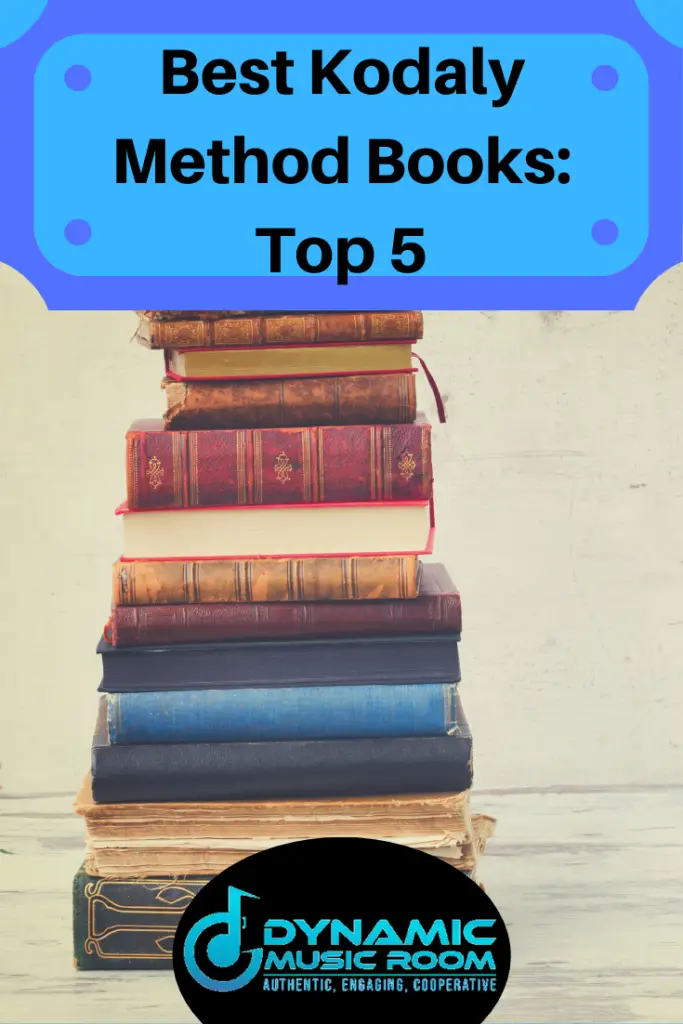Are you looking to buy a Kodaly method book?
Do you feel lost in the huge amount of literature put out there on Kodaly-Inspired teaching?
When I first was introduced to the Kodaly world, I just bought the book I was assigned for the class. Then, when I got more involved, I realized there was a plethora of books out there and not all of them were right for everyone.
So I did some research and asked around to create this list of the best Kodaly method books.
The best Kodaly method books provide song resources, explain the tools of the method, and provide examples of how to teach specific content. My picks for the top Kodaly method books include:
- The Kodaly Method I
- Kodaly In The ____ Classroom
- The Music Effect
- An American Methodology
- Kodaly Approach Method Books
Read the rest of the post for more information on these books.
Table of Contents
About The Kodaly Method
Long story made short, Zoltan Kodaly was frustrated with the poor levels of music education and music appreciation in his native Hungary. In response, he and his graduate students worked to collect folk songs and develop a method of instruction and tools to provide a well-rounded music education for all students.
From these efforts, several important elements arose. I’ll mention these with brief explanations below.
For more details, read some of these articles:
- What is Kodaly training?
- What is the Kodaly method?
- Ta and titi rhythm syllables
- Kodaly rhythm syllables
Music For All
This is one of the overarching slogans of most Kodaly teachers. Kodaly believed all students could learn given the right instruction.
He also believed music instruction and experience should begin young. He said music education should begin 9 months before the birth of the child’s mother.
In essence, he recognized the importance of building a more musical culture.
Native, Authentic Music
People who teach with a Kodaly approach in mind choose songs native to the culture of their students. They also place heavy emphasis on using real music, not music composed for teaching specific ideas.
Positive Music Experience
Though developing musical independence (the ability to perform music without much help) is a main goal, the most important is to create lifelong musicians with a love and appreciation of music.
To make this happen, music teachers should first create an engaging, fun, and positive music experience in their classrooms.
Sound Before Symbol
In Kodaly-inspired teaching, students should work hard to develop a sound concept of musical knowledge before they begin to read the music. This taught through what most Kodaly teachers call Prepare-Present-Practice.
In this sequence, students build knowledge through movement, visual icons, creativity, and aural activities. Then, students label the knowledge with the appropriate solfege and symbols.
Singing First
Despite the common myth, Kodaly did advocate for the use of instruments in music classrooms. However, he did believe the voice was the first and most effective tool for developing musical knowledge.
Singing musical concepts requires more work of the ear and training the connection between brain, ear, and voice.
Sequence Of Concepts
Another important aspect of the Kodaly method is the sequence of concepts As with all instruction, it should move from simple to complex ideas in a logical fashion.
All Kodaly method books will present their own sequence of concepts for students to follow.
While some may disagree, there is no right or wrong as long as you’re intentional and reasonable about the sequence.

Direct Comparison Of The Top Kodaly Books
This chart is a quick reference for the pros and cons of each method book. Use this to help break down which one you want to learn about in more detail.
Review Of The Best Kodaly Books
In this section, I’ll go over each of my picks for the top Kodaly method book (check out solfege books) (check out solfege books). I’ll include pros and cons and what others besides myself have said about the books.
These links may be affiliate in nature which means I earn a small commission if click and buy at no extra cost to you. However, I have all of these books in my personal library and can speak to how awesome they are.
The Kodaly Method I
This book, by Lois Choksy, was one of the original Kodaly method books written for American audiences. As such, it’s easy to tell how the book was written to provide people with little experience in Kodaly with as much explanation as possible.
She starts with an overview of Zoltan Kodaly’s life and what the main points and reasoning behind the method are. From there, she provides a clear explanation of the tools of the method and shares how a large collection of songs fit into those ideas.
The book also includes an example of a sequence stretching throughout elementary. This sequence may seem a bit daunting at first, but remember, this was written when music was valued a little more highly.
The example sequence may be out of reach for you depending on how often you see your kids and other factors out of your control (such as how often you get pulled).
However, she also discusses how you may adapt the sequence or build your own to fit your classroom.
Then, the book goes on to offer sample lessons and scripts for teaching many rhythmic and melodic concepts in the sequence.
While the book won’t do everything for you, making this a book study and keeping it near by will help you improve your teaching.
Pros For This Book:
- Original Kodaly method book in America
- Provides background and explanation of tools
- Gives specific examples of how to teach concepts
Cons For This Book:
- Higher price
- Sequence may be unrealistic for most music teachers (but is easily adapted)
Kodaly In The ____ Classroom
Drs. Houlhan and Tacka have written and provided multiple resources for the Kodaly approach, and their first one was the book, Kodaly Today. People had two strong opinions on this book, they either love it or hate it.
When I first bought the book (before I took any levels), I didn’t like it. It was huge and confusing.
After I took a levels class, the whole book started to make sense. The information was good; the book is just a massive encyclopedia of all things Kodaly.
Houlahan and Tacka heard this criticism and used the feedback to create the Kodaly in the Classroom series. Essentially, they unbundled their big book into grade levels, included more song resources, and shared specific lessons.
As a result, they’ve created an easy series of books for each grade level anyone can pick up and use in their classroom right away.
These books will be useful for anyone, even those with little experience in Kodaly. You’ll be able to essentially open the book and write down the lessons you want to follow with minimal work on your part.
But if you wanted to include other songs or types of activities, the book provides good frameworks for how those extra songs may fit.
Pros For This Book:
- Reasonable price
- Easy to pick up and use right away
- Good explanations of Kodaly tools and techniques
Cons For This Book:
- Must buy each grade level separately requiring multiple purchases
The Music Effect
Without trying to seem biased, I will admit Joy Nelson, author of the books, was one of my Kodaly instructors for my Level I and II classes.
Even if she wasn’t, I still think this book would be one of my favorite resources.
The Music Effect Book 1 and 2 cover the Kindergarten year in detail. She plans out the whole year with a variety of broadly contrasting concepts from the Kodaly perspective.
In the early sections of each book, Dr. Nelson talks a little about Kodaly himself and the ideals of the Kodaly method. She also talks about how the method reaches different learning styles and builds her book around this idea.
Concepts include the following:
- Steady vs unsteady
- Dynamics
- Tempo
- Sound vs rest
- Timbre
- Form (same and different)
- Long vs short sound
- High vs low
- Melodic patterns
These concepts are all pre-literacy concepts and meant to make learning in First grade go smoothly.
The book breaks down each concept with multiple songs, examples of classical music, handouts/projectibles, and dozens of lessons to plug into your classroom without any extra work on your part.
I only wish the series went beyond Kindergarten!
Pros For This Book:
- Great value
- Specific and useful lessons to cover all of Kindergarten
- Lessons built with differentiation and practicality in mind
Cons For This Book:
- Only covers Kindergarten
An American Methodology
Drs. Eisen and Robertson created this method to provide a modern and practical resource update to the Kodaly Method by Choksy. This book is one big guide to Kodaly for all grades and offers specific plans, printables, and song examples for any music teacher to pick up and use.
Like some other method books, this one gives and overview of what Kodaly is and the tools used in teaching a sequential music plan to reach all students.
Because the book is meant to cover all elementary grades, it may not provide as wide a variety of specific lessons (speaking of, check out my favorite elementary music books) (speaking of, check out my favorite elementary music books). However, what it does provide are great examples of how instruction may look, so it isn’t hard to create new lessons from the examples.
Pros For This Book:
- Great foundational resource for Kodaly instruction
- Some specific lessons for inspiration
- Large collection of songs and resources
Cons For This Book:
- High price
Kodaly Approach Method Books
This book by Kodaly legend, Katinka Daniel, is an older one, but it’s good. The examples and printables are immediately useful in classrooms.
Each book is very affordable, although you’ll need all 3 to get the full effect of the method.
Her resources are useful and filled with practical examples of how the method is sequenced and how the tools may be used to provide sequential instruction for all.
The books do provide some basic explanations on the method itself, but I find most people would feel a little left out by the explanations unless they had already taken a levels class.
For those with training, these books are a gem and a perfect supplement to whatever you’re doing.
Note: The songs used were chosen long ago, so there may be some making religious or other references you may wish to skip in modern-day public schools. It’s up to you; use your discretion.
Pros For This Book:
- Good price
- Excellent printable and practical resources
- Large collection of songs
Cons For This Book:
- Need to buy 3 books
- Explanation of the method a little unclear for those untrained in Kodaly
Conclusion
I hope you enjoyed this list of the best Kodaly books. Each one has its merits in its own right, but now it’s up to you to decide which one fits your situation best.
In general, I believe the Kodaly Method by Choksy or the American Methodology provides the best overall resource for teaching with Kodaly in mind. They both have a great combination of resources and teaching tools.
However, if you are looking for specific lesson ideas the Kodaly in the ______Classroom books and The Music Effect provide the most specific help.
Which books do you use or have tried before? Let us know in the comments below.

